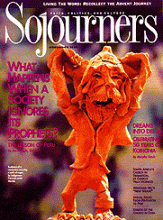On September 12 in Lima, Peru, a special SWAT team captured Abimael Guzman, head of the Peruvian terrorist organization, Sendero Luminoso (Shining Path). For 12 years Guzman, a former university professor, had capitalized on the centuries-old economic and racial divisions in that country, brainwashing and militarizing an organization which grew to an estimated 5,000 to 20,000 members.
Pictures taken of him after the arrest dispelled the romantic notions many people had regarding Guzman, whose overthrow of Peru's government seemed inevitable only months ago and whose ability to evade police entrapment was legendary. The newspapers ran photos of an overweight, dissipated, 57-year-old man, behind the bars of a jail cell, not at all the image of a heroic liberator. The pictures serve also as a metaphor for the organization headed by Guzman.
Sendero Luminoso is nothing more than a rigid, unscrupulous group of ideologues bent on the violent reordering of Peruvian government and society in their own image and likeness. In these 12 years, the Senderistas first terrorized peasants in the Andean highlands, then Mestizos along Peru's coast, and in the last many months rich and poor in Lima. Sendero's atrocities and no less draconian countermeasures by government security forces have resulted in approximately 27,000 deaths.
The economic costs of Shining Path sabotage have run somewhere in the neighborhood of $22 billion - six times the value of Peru's annual exports. People from every strata of Peruvian society have nothing but scorn and fear for the Senderistas. They call them terrucos--a term of opprobrium, roughly translated as "little thugs." The vast majority of the poor--to whom Guzman might be expected to appeal--see Sendero as one more threat in their lives.
Read the Full Article

